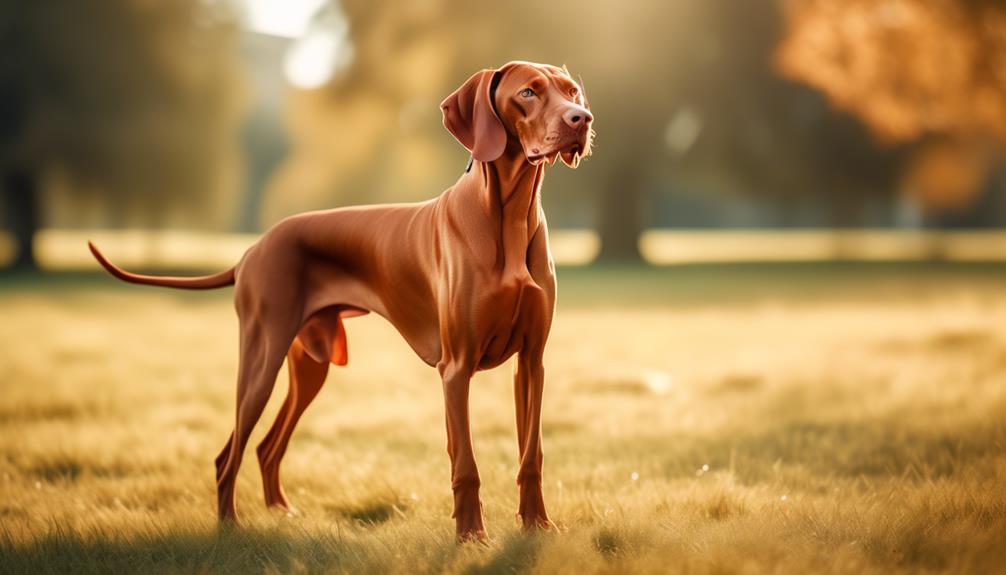
Imagine yourself walking through a picturesque park, the vibrant autumn leaves crunching beneath your feet, when suddenly you spot a graceful, copper-colored dog bounding through the open fields with an air of elegance and enthusiasm. You can’t help but be captivated by this majestic creature, but what exactly is it?
Allow us to introduce you to the Vizsla dog breed. With their keen intelligence and affectionate nature, Vizslas have become a popular choice for those seeking a loyal and loving companion. But there’s more to this breed than meets the eye. In this discussion, we will uncover the unique characteristics and traits that make the Vizsla such a remarkable breed, from their origins and appearance to their temperament and versatility in various roles.
So, join us as we embark on a journey to discover what makes the Vizsla a truly exceptional canine companion.
Key Takeaways
- Vizslas are elegant, intelligent, and enthusiastic dogs that are versatile working dogs.
- When adopting a Vizsla, prioritize adoption from rescue organizations or shelters and thoroughly research reputable breeders.
- Training and care for Vizslas should include early socialization, positive reinforcement techniques, mental stimulation, regular exercise, and establishing a routine.
- Vizslas are described as lively, gentle, and affectionate dogs that require proper exercise to prevent boredom and destructive behavior. They are friendly with children and can get along with other dogs and cats, but may have a strong prey drive towards small pets.
Origin and History
Where did the Vizsla dog breed originate from and what’s its historical significance?
The Vizsla breed originated in Hungary and holds great historical significance. They were favored by nobles and warlords for their hunting abilities, specifically in hunting game birds and hares. Ancient art and manuscripts depict Vizslas accompanying hunters and participating in falconry. They were known as the Hungarian Pointer and were developed to both point and retrieve.
Their elegant appearance and enthusiastic nature made them popular among hunters. Today, Vizslas are versatile working dogs, excelling in hunting, search and rescue, and dog sports. Their historical significance lies in their role as trusted companions to Hungarian hunters and their reputation as skilled and versatile hunting dogs.
See another Dog breed profile.
Weimaraner Dog Breed
Appearance and Coat
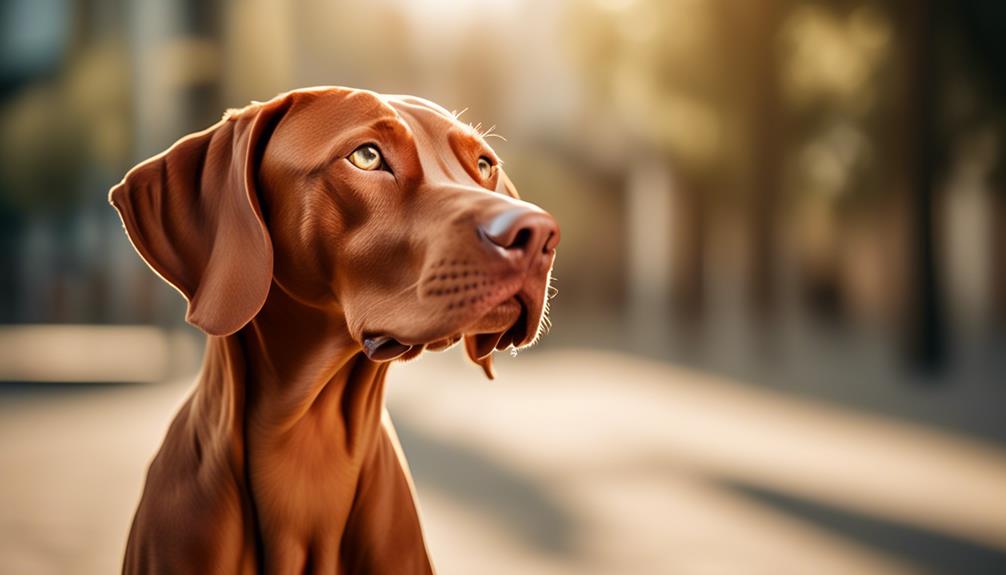
The Vizsla’s appearance is characterized by its elegant and sleek rust-colored coat. This short and dense coat not only enhances its regal look but also provides protection from various weather conditions. The Vizsla’s coat is low maintenance and requires minimal grooming. However, regular brushing will help to keep it clean and remove any loose hairs. The color of the coat ranges from golden rust to dark mahogany, giving the Vizsla a distinctive and eye-catching appearance. To help you visualize the Vizsla’s stunning coat, here is a table showcasing the various coat colors and their descriptions:
| Coat Color | Description |
|---|---|
| Golden Rust | Bright and vibrant shade of rust with a golden hue |
| Dark Mahogany | Deep and rich shade of reddish-brown |
| Light Amber | Pale and delicate shade of amber |
The Vizsla’s coat is truly a testament to its beauty and elegance, making it a standout breed in the canine world.
Temperament and Personality
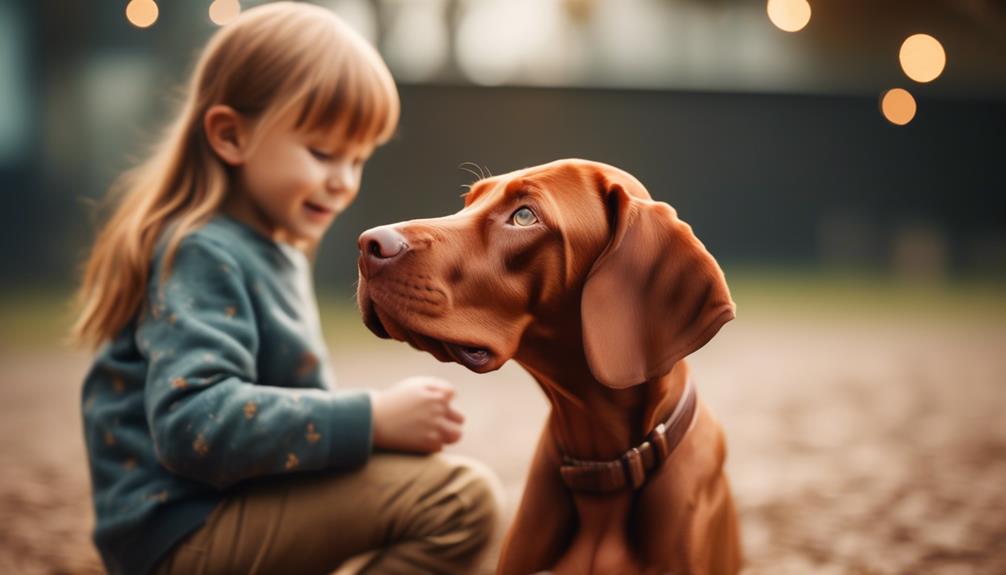
Moving on from the discussion on the Vizsla’s elegant appearance and coat, let’s now explore their temperament and personality.
Vizslas are known for their lively, gentle, and affectionate nature. They’ve above-average learning ability and a strong desire to be with people. However, they can be stubborn, excitable, or shy at times.
These energetic and athletic dogs require proper exercise to prevent boredom and destructive behavior. Early socialization is essential for a well-rounded Vizsla.
They’re generally friendly and tolerant with children and can get along with other dogs and cats, especially if raised together. However, they may have a strong prey drive towards pet birds and shouldn’t be trusted around small animals like rabbits, hamsters, or gerbils.
Versatility in Working Roles
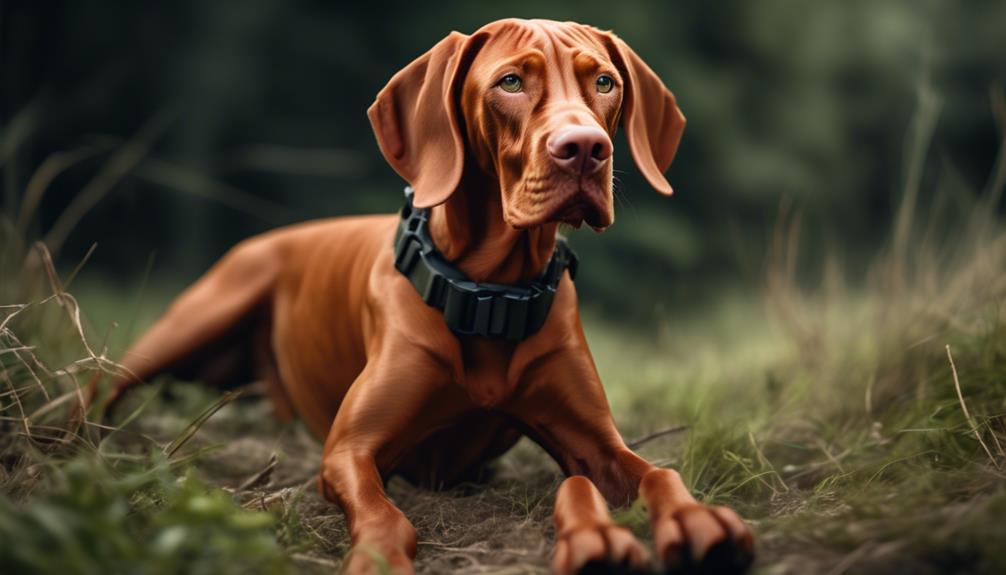
Vizslas showcase their versatility in various working roles. They excel in hunting, search and rescue, and dog sports. Vizslas have a keen sense of smell and excellent tracking abilities, making them ideal hunting companions.
They are also highly trainable, making them valuable assets in search and rescue operations. With their intelligence and athleticism, they excel in various dog sports such as agility, obedience, and dock diving.
Their natural athleticism and enthusiasm make them well-suited for these activities, and they thrive when given the opportunity to participate. Whether it’s tracking game, finding missing persons, or competing in dog sports, Vizslas are capable of adapting to different working roles with ease.
Adoption Considerations
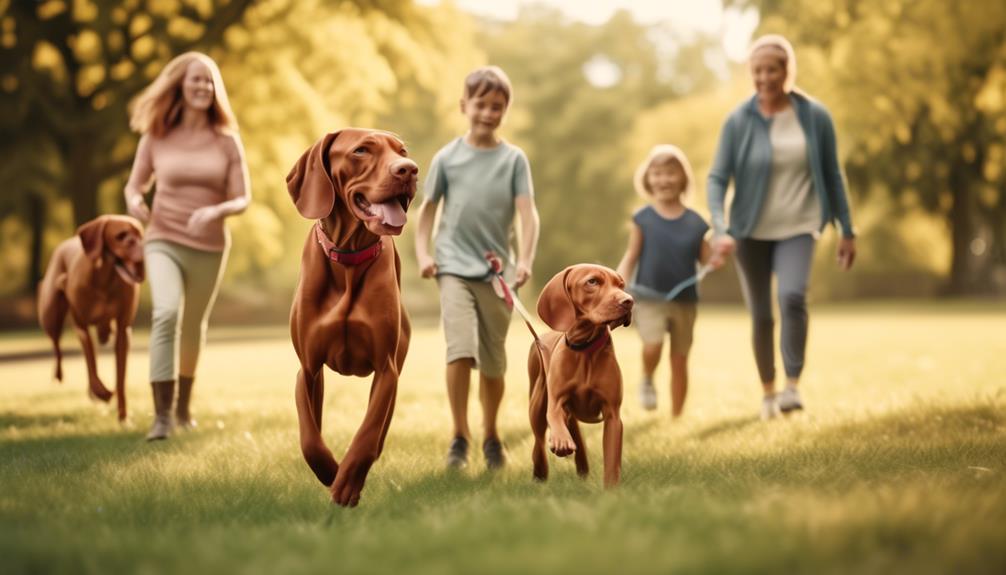
As you explore the topic of Vizslas’ versatility in working roles, it’s important to consider several factors when it comes to adoption.
- Prioritize adoption from rescue organizations or shelters to provide a loving home to a dog in need.
- Conduct thorough research on reputable breeders to ensure ethical breeding practices and prioritize the well-being of the dog. Reputable breeders prioritize health, temperament, and necessary screenings.
- Start early with socialization and obedience training, using positive reinforcement techniques. Consistency and patience are key in training and care for Vizslas.
- Provide mental stimulation and regular exercise, seeking professional training assistance if needed.
- Establish a routine and frequent potty breaks for housetraining, using positive reinforcement for successful elimination.
- Supervise and confine the puppy when unsupervised, and clean accidents with enzymatic cleaners to remove odors.
Researching Reputable Breeders

To ensure the well-being and health of your future Vizsla, it’s essential to thoroughly research reputable breeders. When researching breeders, keep in mind the following:
- Look for breeders who prioritize the health and well-being of their dogs. They should conduct necessary health screenings and genetic testing to ensure the puppies are healthy.
- Reputable breeders will prioritize the temperament of their dogs. They’ll focus on breeding Vizslas with the right temperament, which is affectionate and loyal.
- Ethical breeders will provide proper socialization for their puppies. This is crucial for the development of a well-rounded and well-behaved Vizsla.
Training and Socialization

When looking for a reputable breeder for your future Vizsla, it’s important to consider their approach to training and socialization. Vizslas are intelligent and eager to please, making them highly trainable.
Early socialization is crucial to ensure a well-rounded and confident dog. Reputable breeders prioritize socializing their puppies from a young age, exposing them to various people, animals, and environments. This helps Vizslas develop good manners and adaptability.
Positive reinforcement techniques, such as rewards and praise, work best with this breed. Consistency and patience are key during training sessions. Seeking professional training assistance can be beneficial if needed.
Care and Exercise Requirements
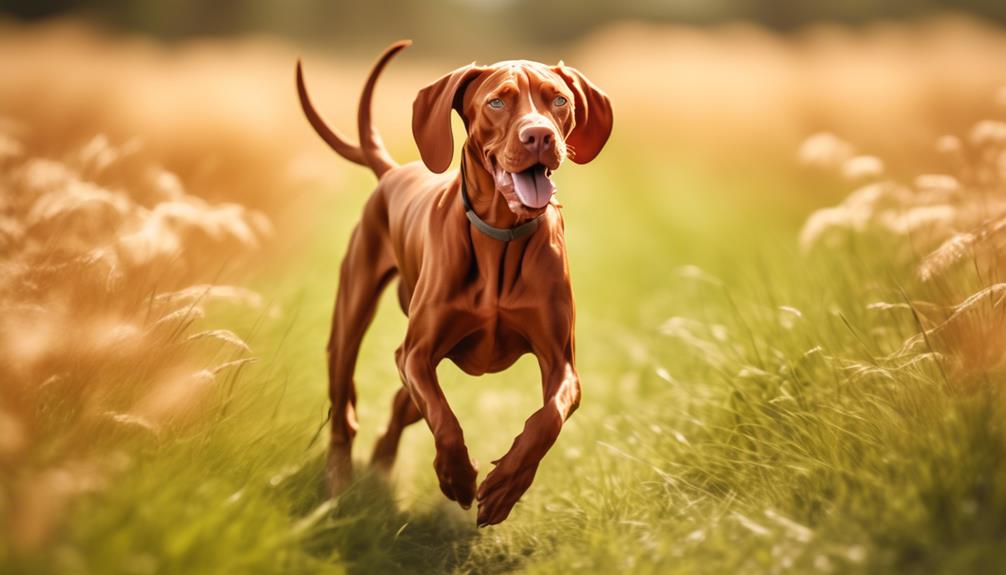
Meeting the care and exercise requirements of a Vizsla is essential for their overall well-being and happiness. To ensure your Vizsla stays healthy and content, here are three important guidelines to follow:
- Provide regular exercise: Vizslas are energetic and athletic dogs that require daily exercise to keep them physically and mentally stimulated. Aim for at least two half-hour workouts each day, which can include walks, runs, or games of fetch.
- Offer mental stimulation: Along with physical exercise, Vizslas thrive when given mental challenges. Engage them with puzzle toys, obedience training sessions, or canine sports activities to keep their minds sharp.
- Make them part of your family: Vizslas are social dogs that crave companionship. They should live indoors with their human family and not be left alone in the yard for extended periods. Provide a fenced yard for safe play and offer plenty of chew toys to prevent destructive behavior.
Housetraining Tips

To successfully housetrain your Vizsla, it’s important to establish a consistent routine and implement effective training techniques. Consistency and patience are key during the housetraining process. Here are some tips to help you along the way:
| Tips for Housetraining Your Vizsla | Emotional Response |
|---|---|
| Establish a routine | Stability |
| Take your Vizsla out frequently | Responsibility |
| Use positive reinforcement | Encouragement |
| Clean accidents with enzymatic cleaners | Cleanliness |
Feeding Guidelines and Weight Management

Feeding your Vizsla according to proper guidelines and managing their weight is essential for their overall health and well-being. To ensure your Vizsla is properly nourished and maintains a healthy weight, keep in mind the following guidelines:
- Provide high-quality dog food: Choose a nutritionally balanced dog food that meets the specific needs of your Vizsla.
- Measure food and feed twice a day: By measuring the food and dividing it into two meals, you can control portion sizes and prevent overeating.
- Assess weight regularly: Use visual and hands-on tests to monitor your Vizsla’s weight and adjust their food intake accordingly.
Characteristic Traits and Behavior
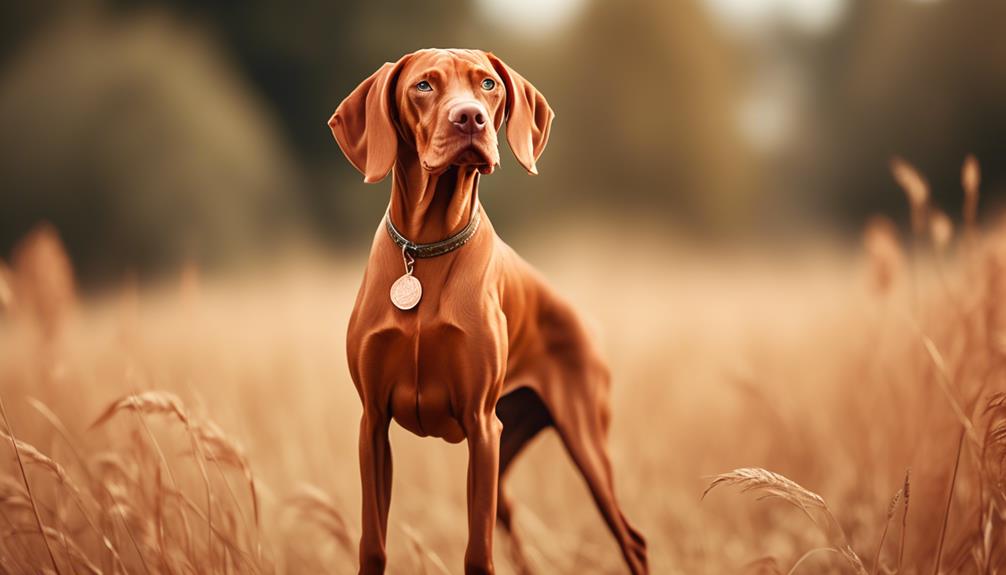
Vizslas exhibit distinctive traits and behaviors that make them a unique and captivating dog breed. They’re described as lively, gentle, and affectionate, with above-average learning ability and a strong desire to be with people. However, they can also be stubborn, excitable, or shy in some cases.
Vizslas are energetic and athletic, so it’s important to properly exercise them to prevent boredom and destructive behavior. Early socialization is necessary to ensure a well-rounded dog. They’re generally friendly and tolerant with children, but supervision is still important.
Vizslas get along well with other dogs and can even be friends with cats if raised together. However, they may have a strong prey drive towards small pets like rabbits or hamsters.
Interactions With Children and Other Animals
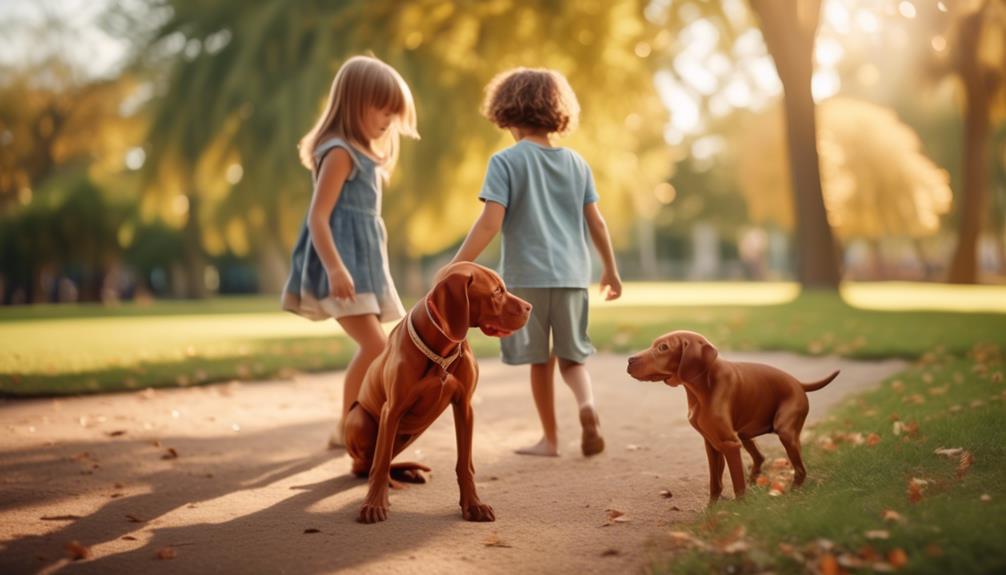
How do Vizslas interact with children and other animals?
Vizslas are known to be friendly and tolerant with children, making them great family pets. However, it’s important to teach children how to approach and touch dogs, and to always supervise interactions between dogs and kids.
Vizslas also generally get along well with other dogs, and they can be friends with cats, especially if they’re raised together. However, it’s important to note that Vizslas may have a strong prey drive towards pet birds and shouldn’t be trusted around small pets like rabbits, hamsters, or gerbils.
When introducing a Vizsla to a household with children or other animals, it’s always best to proceed with caution and ensure proper supervision to promote a harmonious and safe environment for all.
Prey Drive and Small Pets
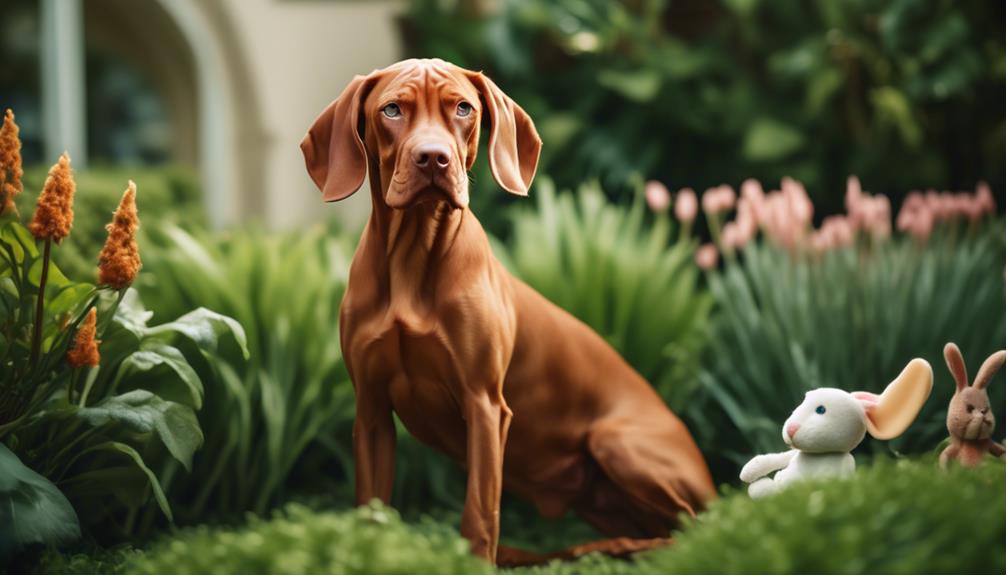
When introducing a Vizsla to a household with small pets, it is important to be mindful of their strong prey drive. Vizslas have a natural instinct to chase and hunt small animals, which can put small pets like rabbits, hamsters, or gerbils at risk. While Vizslas can get along with cats, especially if raised together, their prey drive may still be triggered towards pet birds. To help manage their prey drive and ensure the safety of small pets, it is recommended to closely supervise interactions between a Vizsla and small animals, and never leave them unsupervised. Additionally, providing separate living spaces for small pets and using baby gates or crates can help prevent any potential accidents or harm.
| Small Pets | Compatibility with Vizslas | Recommendations |
|---|---|---|
| Cats | Generally compatible | Raise them together |
| Pet Birds | Strong prey drive | Close supervision |
| Rabbits | Not recommended | Separate living spaces |
| Hamsters/Gerbils | Not recommended | Separate living spaces |
Health Concerns and Screening

To ensure the overall health and well-being of your Vizsla, it’s important to address any potential health concerns through proper screening methods. Here are three key aspects to consider:
- Regular Health Check-ups: Schedule regular visits with a veterinarian to monitor your Vizsla’s overall health and catch any potential issues early on. These check-ups may include physical examinations, vaccinations, and blood tests.
- Genetic Testing: Some Vizslas may be prone to certain genetic conditions. By conducting genetic testing, you can determine if your dog carries any genetic markers for these conditions. This information can help you make informed decisions about breeding and preventative care.
- Hip and Elbow Evaluation: Vizslas can be susceptible to hip dysplasia and elbow dysplasia. It’s crucial to have your dog’s hips and elbows evaluated by a veterinarian to assess their joint health and detect any signs of these conditions.
Importance of Reputable Breeders
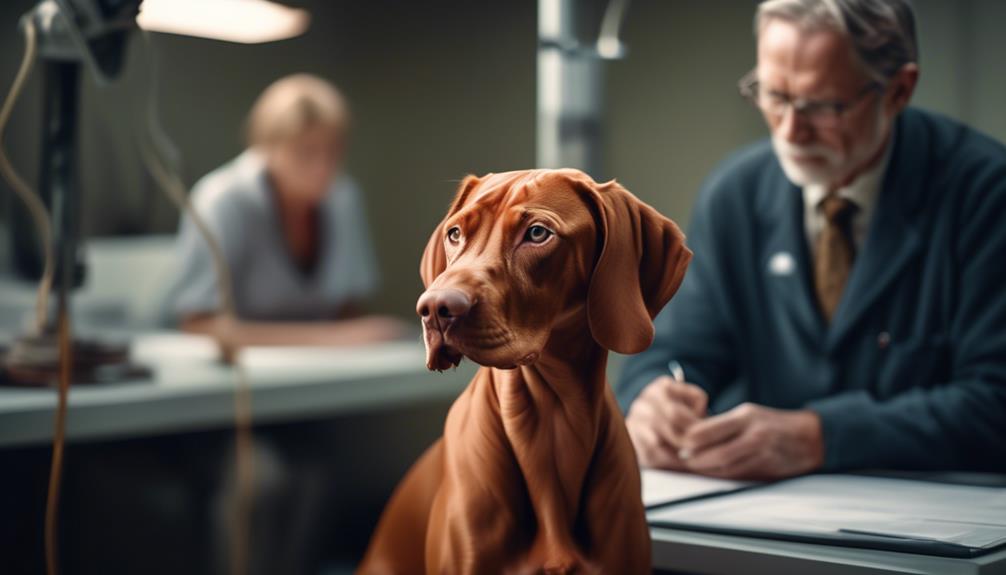
Reputable breeders play a crucial role in ensuring the health and well-being of Vizslas. When getting a Vizsla, it’s important to find a breeder who prioritizes breeding healthy and well-socialized puppies. These breeders go above and beyond to screen their breeding stock for health problems, ensuring that puppies are less likely to inherit genetic conditions. They also focus on proper socialization from a young age, setting the foundation for a well-rounded and confident dog.
Reputable breeders provide lifetime support, offering guidance and assistance throughout the dog’s life. On the other hand, backyard breeders prioritize profit over the health of the dogs they breed. They often neglect health screenings and proper socialization, resulting in puppies with potential health and behavioral issues.
Frequently Asked Questions
Are Vizslas Hypoallergenic?
No, Vizslas are not hypoallergenic. They have a short, sleek coat that sheds moderately. If you have allergies, it’s important to spend time with a Vizsla before bringing one into your home.
Can Vizslas Be Left Alone for Long Periods of Time?
No, vizslas cannot be left alone for long periods of time. They are social dogs and thrive on human companionship. Leaving them alone for extended periods can lead to separation anxiety and destructive behavior.
Do Vizslas Require Grooming?
No, Vizslas do not require grooming. Their short, sleek coat is low maintenance and does not shed excessively. Regular brushing and occasional baths are sufficient to keep them clean and looking their best.
Are Vizslas Good Guard Dogs?
No, Vizslas are not typically good guard dogs. They are friendly and tolerant with people, including strangers. Their affectionate nature and desire to be with people make them more suitable as loving companions rather than protective guard dogs.
Can Vizslas Live in Apartments or Small Homes?
Yes, Vizslas can live in apartments or small homes, but they need plenty of exercise and mental stimulation. Make sure to provide regular walks and playtime to keep them happy and healthy.
Conclusion
In conclusion, if you’re looking for a furry companion that’s elegant, intelligent, and enthusiastic, the Vizsla dog breed may be the perfect choice for you.
Their loyalty and affection make them wonderful companions, whether you’re a seasoned dog owner or a first-time adopter.
With proper training and care, you can ensure a happy and healthy relationship with your Vizsla.
Remember to always choose a reputable breeder and consider the unique characteristics and needs of this remarkable breed.




